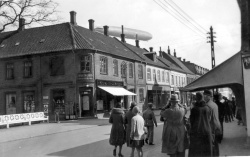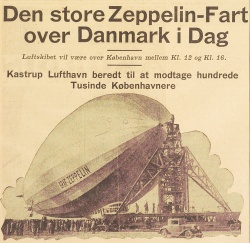The Airship is Coming!
01. Jan. 2006

Graf Zeppelin on its way across Danmark - here floating over the rooftops of Fredericia. Photo: Local Historical Archives of the Fredericia region.
Today we take it for granted that we can send messages across the Atlantic in a few seconds. But in 1929 when the Graf Zeppelin managed to fly around the earth in 12 days it was a sensation beyond compare. A few years later scheduled services were established between Europe and America. In that way it took merely three days for a letter to cross the Atlantic. Previously, steamships had been the only possibility, but with the Graf Zeppelin the time of transmission was shortened by an entire week.
The Airship is Loaded with ...
The special design of the airships made them lighter than air. The enormous hull contained large gas cells filled with hydrogen - a highly inflammable gas which is lighter than air, but also difficult to se-cure and dangerous to handle. The higher weight of the airship, the more hydrogen is needed to ele-vate it. With both crew, passengers, mail, and cargo on board a light design was required to keep the size of airship within reason.
The Graf Zeppelin measured 236.6 m and had room for 20 passengers. Although it had the capacity to convey relatively few passengers, it was in no way "a little thing" that had been built in Friedrichsha-fen in 1928. It was a gigantic machine which was driven by its aerodynamic shape and its five diesel engines.
The first zeppelin undertook its maiden voyage in 1900. During the following years designs and tech-niques were adjusted and refined, and already from 1910 the airships were used for transport of mail within the borders of Germany. Airmail was on board every flight and as the zeppelins were eventually able to fly longer, they became an advantage to letter writers all over the world.

Even the porcelain on board the Graf Zeppelin was specially designed. LZ stands for Luftschiffbau Zeppelin GmbH. Photo: Zeppelin Museum Friedrichshafen.
Communication across Borders
The zeppelins were floating communication centres equipped with the most advanced radio technology of the time. Radio signals were used for navigating as it was essential to know the position of the airship at all times, but even more important to keep abreast of the weather situation. High above the clouds the crew was unable to navigate by landmarks, but was dependent of the radio sta-tions on the ground which telegraphed back to the airship continuously enabling it to determine its exact position on the map relative to the radio sta-tion. From the radio stations on the ground the air-ship received weather reports at short intervals enabling the captain to avoid bad weather which at worst might cause the airship to crash.
The internal communication inside the zeppelin was just as important as the external one. The dis-tances between the crew members in the gigantic airships were considerable and many posts were not very accessible. Orders about course, speed, and height were communicated via speaking tubes, telephone installations, and engine telegraphs. A substantial degree of expertise was required to make the fantastic constructions sail safely across oceans and continents.

Everybody was excited and the journalists were on the spot when the Graf Zeppelin shaped course for Denmark. The newspaper Politiken of 14th May 1931.
Ready for Take-Off
The exhibition takes the visitors on a journey start-ing on 14th May 1931. The public step inside to suddenly find themselves on the street beneath the silhouette of Copenhagen. The sun is shining and people in the street have stopped and are staring at the sky, fascinated: The airship is coming! A 236 metres long, silvery zeppelin is hovering above the rooftops and spires. The Graf Zeppelin is greeting the Copenhageners on its Nordic circular tour.
It must have been a marvellous sight to see it glide over the rooftops. Many spectators must have dreamed about being a passenger.
Post & Tele Museum grants the public the oppor-tunity to dream along. The moment has been re-created and the Graf Zeppelin is floating in the air ready for take-off: Board the airship and see what life was like in ethereal regions.
Inside the gondola stories are told about the daily life as a passenger, about the reporters who shared the events of the journey with the world below, and not least about the crew who made sure that the right course was shaped.
The gondola is inclining and the visitors must take care not to become seasick, but if you get off in time, there are other adventures and histories to meet. On the way through the exhibition towards the large reconstruction of the hull of the zeppelin you pass among other things the section with fascinat-ing stories about Graf Zeppelin's journey through Denmark and the crash of the zeppelin L3 on the island of Fanoe before you step into a coulisse which gives you a vertiginous insight into the working conditions of the crew. Post & Tele Museum has attempted to recreate a small part of the rigid frame-work construction and the passage which enabled to crew to get from one end of the hull to the other.
A Unique Opportunity
It is the first time that the fantastic exhibits are being presented in Denmark. The exhibition predomin-antly consists of original objects borrowed from the Zeppelin Museum in Friedrichshafen as well as borrowings kindly made available by a large number of museums, archives, and private collectors. This has enabled us to tell about the successful era of the zeppelins and to spice the story with excep-tional photos, stamps, postal items, and spectacular objects. In the scenography of Lars Haastrup visitors are given the opportunity to get close to the giant of bygone days which formed the framework of a combined luxury hotel and a functioning office for celestial mail - indeed a demanding place of work.
The exhibition "The Airship is Coming" can be seen on the 4th floor of Post & Tele Museum during the period 10th February to 22nd October 2006.
This article may be copied or quoted with MuseumsPosten, Post & Tele Museum as source.
Comment this article
Only serious and factual comments will be published.